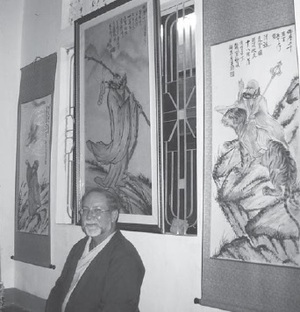By Jack Lawlor

There is a famous metaphor in the Avatamsaka Sutra about the Jeweled Net of Indra, which likens the interdependent, interwoven nature of reality to a vast net of jewels in which each jewel is reflected in the other.
The Sanghas that have been inspired by Thich Nhat Hanh’s teachings resemble the Jeweled Net of lndra. They too are vast, now extending throughout the world.
By Jack Lawlor

There is a famous metaphor in the Avatamsaka Sutra about the Jeweled Net of Indra, which likens the interdependent, interwoven nature of reality to a vast net of jewels in which each jewel is reflected in the other.
The Sanghas that have been inspired by Thich Nhat Hanh’s teachings resemble the Jeweled Net of lndra. They too are vast, now extending throughout the world. They extend from the Tu Hieu Temple in Hue, Vietnam (our Root Temple where Thay at age sixteen began practicing and studying as a novice), to Plum Village in France, to affiliated monastic practice centers in China and Korea, to our Deer Park and Blue Cliff major practice centers in North America, to twenty-year old Sanghas comprised primarily of lay practitioners located throughout the world, and to the newest Sanghas just formed in a practitioner’s living room.
Each of these jewels reflects the others. Although they may be separated by oceans, although their membership is comprised of practitioners from much different cultures, although some Sanghas are considerably older than others, they each reflect what’s shared in common: a deep reverence for mindfulness practice and a characteristically gentle but wholehearted aspiration to be mindful in everything we say and do—not only for our own benefit but for the benefit of all beings.
Stop, Be, Look, See
Early in his efforts to inspire the growth of the Dharma in the West, Thay asked lay practitioners to master just three things: sitting meditation, walking meditation, and the use of the breath poems known as gathas. The equanimity we nourish through the practice of conscious breathing in the form of sitting meditation, walking meditation, and daily gatha practice manifests not only in stress reduction, but also in enhanced understanding and insight, helping us know what to do and what not to do even in the most perplexing situations. Thay summarized mindfulness to North American practitioners in the late 1980s in a simple four-word breath poem: Stop, Be, Look, See.
We are so fortunate that Thay also impresses upon us the need to live in an ethical manner consistent with the Five Mindfulness Trainings, which in so many ways help us remain together as a healthy, happy community. Another great fortune is the emphasis Thay places on Sangha practice itself. When we practice meditation and mindfulness with others, we receive loving feedback through the shared practice of deep listening and appropriate speech, and our rough edges become smooth. Our spiritual practice grows, rather than become either the fond memory of a retreat we attended or a book we once enjoyed.
With a modest degree of persistence, we soon learn how much easier it is to practice together than alone; how we contribute to a Sangha without the need to say very much because our presence is in and of itself a gift that supports and authenticates the practice of other Sangha members; how we are inherently social beings who need the interaction and support that may not be forthcoming from books and tapes; and how someone in our Sangha will likely have been down the same road we’re traveling and have the ability to listen to us and understand us.
We’ve all experienced tastes of the grace and ease that arise when we practice together as a Sangha rather than alone. We’ve all taken our place on our meditation cushions at home, observed that it is 7:00 a.m., done our best to sit through 35 minutes of sitting meditation, only to peek at our watch and find that it is 7:03! Yet when we sit together as a Sangha, we sit in a relaxed way free of such tension and anxiety, because we have the support of friends on the same step-by-step spiritual journey.
Spiritual Friends on the Path
It is now approximately six years since I helped Thay and our Sanghas throughout the world assemble the Parallax Press manual on Sangha building and practice entitled Friends on the Path. I have continuously marveled at the effectiveness of Sangha practice and come to realize why the Sangha—together with the Buddha and his teachings, the Dharma—are regarded as the Three Jewels in the Buddhist tradition shining so brightly within Indra’s net.
There is a beautiful term in the Pali language, kaylana mitta, that describes the kind of spiritual friend we can be to one another. I have seen assemblies of kaylana mitta do so many things quite well without the benefit of resources other than their friendship and their dedication to mindfulness practice. I have witnessed how local Sanghas develop consistency in individuals’ sitting and walking meditation practices to the point where they are deeply woven into each practitioner’s life. I have seen how Sangha practice encourages Sangha members who were alienated from their blood families and their children to reconcile. I have witnessed how Sanghas help Sangha members in time of need, and even serve as primary caregivers as a Sangha member approached death. It has been encouraging to see how our Buddhist faith community contributes to political dialogue by joining hands with other faith communities in efforts to stop war and prevent further ecological destruction.
Perhaps you, like me, have seen local Sanghas serve their communities in countless ways, including working with the homeless and raising funds for charitable causes both in North America and overseas. It is clear that our Sanghas and Sangha members serve in innumerable ways, without a lot of fanfare, setting examples in work places and in other social settings that have helped place the Dharma seed deep in the social fabric of the West.
Only twenty years ago, Thay opened our eyes to the possibility of Sangha practice at a time when a large Sangha would have been six or seven people sitting together in a dining room. Today, this Jeweled Net manifests in Sanghas and monastic practice centers throughout the world in which thousands of people participate. Yet all this has been accomplished in a surprisingly short period of time with no sense of hurry, in the spirit of one step, one breath. When I first met Thay twenty years ago near the busy baggage claim at O’Hare International Airport, and soon thereafter found myself following his example of practicing airport walking meditation toward my car, I realized instantly that this lineage would have its impact upon our world in no other way.
What lies ahead? Thay has predicted that the next Buddha may indeed be a Sangha. That prediction will manifest if each of us infuses our lives consistently with the most basic mindfulness practices based on conscious breathing, and if we keep doing so together with a light, loving touch, as kaylana mitta, friends on the path.
Jack Lawlor, True Direction, was ordained by Thay as a Dharma Teacher in 1992. Jack was a co-founder of Lakeside Buddha Sangha in Evanston, Illinois and practices extensively with Sanghas in the American Midwest.

